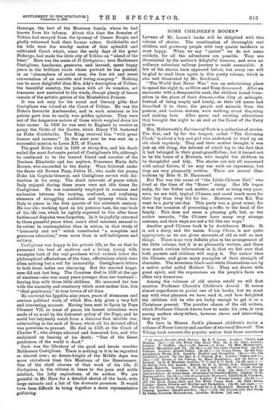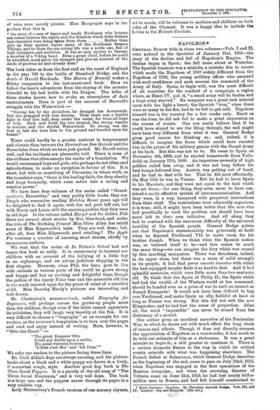SOME CHILDREN'S BOOKS.*
LOVERS of Mr. Lucas's books will be delighted with this volume of stories. The combination of thoroughly real children and grown-up people with very quaint incidents is most happy. When we say "quaint" we do not mean unlikely, for all the adventures are possible. They are illuminated by the author's delightful humour, and even an ordinary suburban railway journey is made memorable. A few of the stories have appeared before, but every one will be glad to read them again in this pretty volume, which is also well illustrated by Mr. Buckland.
"The World that Never Was" was an entertaining place to spend the night in, as Olive and Tony discovered. After an encounter with a disagreeable aunt, the children found them- selves in the place of their dreams,—the City at midnight. Instead of being empty and lonely, as their old nurse had described it to them, the people and animals from the posters, and various statues, were walking about disputing and making love. After queer and exciting adventures they brought the night to an end at the Court of the Fairy Queen.
Mrs. Molesworth's Fairies—of Sorts is a collection of stories. The first, and by far the longest, called "The Groaning Clock," is about a boy and girl who undertook to wind up an old clock regularly. They and their mother thought it was just an old thing, the interest of which lay in the fact that it had belonged to their great-grandfather ; but it turned out to be the home of a Brownie, who taught the children to be thoughtful and tidy. The stories are not all concerned with actual fairies, if we may use such an expression, but they are very pleasantly written. There are several illus- trations by Miss G. D. Hammond.
Kai Tzu was the name of "the Little Chinese Girl," who lived at the time of the "Boxer" rising. Her life began sadly, for her father and mother, as well as being very poor, were, we are told, typical Chinese, and cared much more for their boy than they did for her. However, even Kai Tzu went to a party one day. This party was a great event, for it was the occasion of presenting a coffin to the head of the family. This does not seem a pleasing gift, but, as the author remarks, "the Chinese have many very strange customs, and their ways are not a bit like our ways."
Another good Chinese book is by Archdeacon Moule. It is not a story, and the name, Young China, is not quite appropriate, as we are given accounts of old as well as new things. There is no very definite plan in the arrangement of the little volume, but it is so pleasantly written, and there is so much curious information in it, that we feel sure that both parents and children will enjoy it. The author likes the Chinese, and gives many examples of their strength of. character. The seventeen black-and-white illustrations are by a native artist called Mathew Tai. They are drawn with great spirit, and the expressions on the people's faces are. often very humorous.
Among the volumes of old stories retold we will first mention Professor Church's Children's Aeneid. It seems almost superfluous to praise one of his books, but we must say with what pleasure we have read it, and how delighted the children will be who are lucky enough to get it as a. Christmas present. The peculiar charm of the old writers, which Professor Church knows how to make his own, is rare among modern story-tellers, however clever and interesting. they may be.
We have in Messrs. Jack's pleasant children's series a. volume of Norse history and another of stories of Beowulf. The Viking book corrects the popular notion that these ancestors
• (1) Anne's Terrible Good Nature. By E. V. Lucas. London : Chatto and Windus. [6,.1 —(2) The World that Never Was. By A. St. John Adcock. London : F. Griffith. [66.]—(3) Fairies—of Sorts. By ii12. Molesworth. London : Macmillan and Co. [3s. 6d...I —(4) The Little Chinese Girl. By Nell Parsons. London : Robert Caney. 12s. 6d.] —(5) Young China. By the Von— Archdeacon Monte, B.D. London : Hodder and Stoughton. [2s.]—(6) The Children's Aensid. By the Rev. A. J. Church, M.A. London : Seeley and Co. [5s.]--(7) Stories of the Vikings, by Nary Macgregor ; and (8) Stories or Beowulf, by H. E. Marshall. London : T. C. and E. C. Jack. [1s. 6d. each.]— (9) Stones from Don Quixote. Retold by H. L. Havell, B.A. Illustrated by Ernest Marriott. London : G. G. Harrsp and Co. [2e. ed.]—(19) Grand. mother's Favourites. London : T. C. and E. C. Jack. [2s. each.) —(11) Naturs's School. By Lilian Gast. Illustrated by Dorothy Hardy. London : G. G.. Harnitailra... 6c1.3—(12) Biography for Beginners. Edited by E. Clerihew„ RA. ms G. K. Chi:I:Merton. London : T. Werner Laurie. [Si. 6d.]— (13) The lack Puppy Book, and The White Puppy Book. By CecilAldin. London; Hairy FrowJe and Hodder and Stoughton. 12s. 6d. net °ugh.] — (14) The Three Jovial Puppies. Pictures by J. A. Shepherd. Rhymes by E. D. darning. London : Blackle and Son. Pal —(I5) Old Friends with Tins Faces‘ By Susan, Countess Mahnesbury. London: Mans. [6d. net.]
of ours were merely pirates. Miss Macgregor says in her preface that this is " the story of a race of brave and hardy Northmen who became sea rovers because the rights and the freedom which their fathers had cherished were being taken from them Bather than give up their ancient rights many of the Northmen became Vikings, and to them the sea roving life was a noble one, full of high enterprise and ambition. It was no easy matter to become a 'member of a Viking band. Even a great chief, before he could be admitted, must prove his strength and give an account of the deeds of prowess he had already done."
The book takes us from the first raid on the coast of England in the year 789 to the battle of Stamford Bridge and the death of Harald Hardrada. The Stories of Beowulf makes a fitting companion to the last-mentioned book. Here we follow the hero's adventures from the slaying of the monster Grendel to his last battle with the Dragon. The teller of these stories knows how to evoke an atmosphere of dark enchantments. Here is part of the account of Beowulf's struggle with the Waterwitch :— " Seizing her by the shoulders, he dragged her downwards. But she grappled with him fiercely. Then there was a fearful fight in that dim hall, deep under the water, far from all hope of help. Back and forth the two swayed, the strong warrior in armour, and the direful Waterwitch. So strong was she that at last she bore him to the ground and kneeled upon his breast."
There could hardly be a greater contrast in temperament and climate than between the Stories from. Don Quixote and the Norse tales from which we have just quoted. Mr. Havell writes well, and the incidents are pleasantly told. There is none of the stiffness that often annoys the reader of a translation. We would recommend boys and girls, who perhaps do not often read introductions, to make an exception in favour of this. It is short, but tells us something of Cervantes, in whose work, as the translator says, "there is the healing faith, the deep charity and large humanity, which raise satire into a saving and creative power."
We have here four volumes of the series called "Grand- mother's Favourites," and very pretty little books they are.
People who remember reading Holiday House years ago will be delighted to find it again, with the sad part left out, but with Harry and Laura still the amusing pickles that they were in old days. In the volume called Margot and the Golden Fish there are several short stories by Mrs. Sherwood, and under the title of The Birthday Present Miss Olive Allen has retold some of Miss Edgeworth's tales. They are well done ; but, after all, does Miss Edgeworth need retelling P The Apple Pie contains a number of amusing short stories, chiefly by anonymous authors.
We wish that the writer of In Nature's School had not begun this book so sadly. It is unnecessary to torment our children with an account of the bullying of a little boy in an orphanage, and we advise judicious skipping in the first chapter. However, when Phil, the hero, goes to live with animals in various parts of the world he grows strong and happy, and has an exciting and delightful time, though the pathos of the lonely Polar bear and the miserable old lion is too much insisted upon for the peace of mind of a sensitive child. Miss Dorothy Hardy's pictures are interesting and well drawn.
Mr. Chesterton's nonsense-book, called Biography for Beginners, will perhaps amuse the grown-up people more than the children, though even if the latter cannot appreciate its subtleties, they will laugh very heartily at the fun. It is very difficult to choose a " biography " as an example for our readers, as the reviewer's temptation is to turn over the pages and read and enjoy instead of writing. Here, however, is "Otto the Great" :— "The great Emperor Otto Could not decide upon a motto, His mind wavered between • L'Etat &est Moi ' and • Iola Dien."
We refer our readers to the picture facing these lines.
Mr. Cecil Aldin's dogs are always amusing, and his picture.
books about a black and a white puppy are drawn in a lively, if somewhat rough, style. Another good dog book is The Three Jovial Puppies. It is a parody of the old song of "The
Three Jovial Huntsmen," and is very well done. The book is a large one, and the puppies career through its pages in a very realistic way.
Lady Malmesbury's French versions of our nursery rhymes,
set to music, will be welcome to mothers and children on both sides of the Channel. It was a happy idea to include the bibles in the Entente Cordiale.







































































 Previous page
Previous page